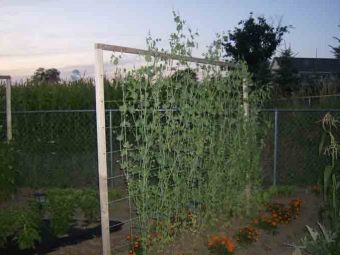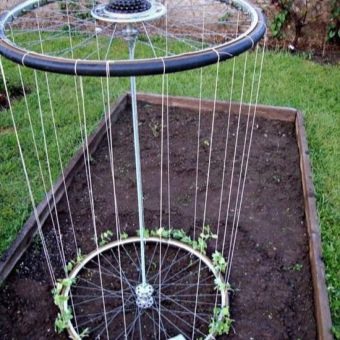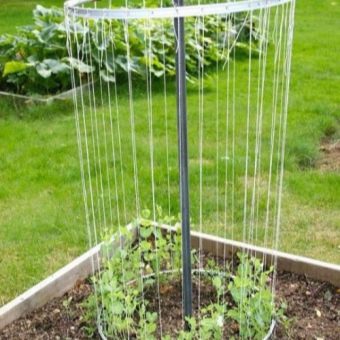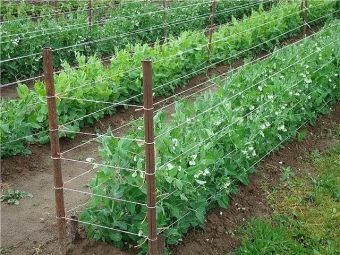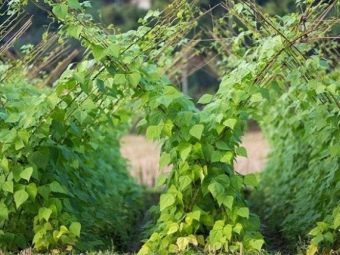How to tie peas?
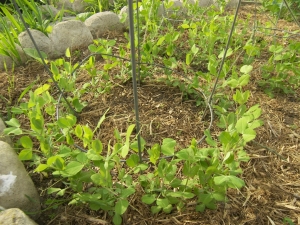
The taste of sweet young peas is familiar to all since childhood. This culture has long taken root in the cottages, becoming one of the favorites.Someone planted only one or a couple of beds, and someone planted whole pea plantations. To the peas turned out to be even tastier, it is necessary to properly care for him. A significant role in this process is assigned to the garter of pea bushes.
What is it for?
Peas seem to be one of the simplest legumes that can be easily grown in the garden. However, even he needs the right care, which allows him to grow a good harvest. Of course, we all know that watering, weeding and fertilizer is important. But no less important is the timely garter bushes.
It is worth starting with the fact that neatly tied bushes even look better, not to mention the repeated benefits of the garter. If the bushes are not tied up vertically or tilted in time, they will get much less sunlight. As a result, the ripening of peas will be very uneven, and their taste is not so sweet.
Only with the support you can get delicious sweet peas on all stalks.
Another reason why it is worth tying peas is rotting. In contact with the soil, the pods and stems begin to rot faster. This is especially evident in the period of heavy rain. Thus, tying bushes, you can get a much larger amount of harvest from healthy plants.
In addition, pea pods, which lie on the ground, quickly find and damage bruchus. This pest, which is very dangerous for legumes, is also called the pea weevil. The peas it damages contain cantharidin (a toxic substance), so they cannot be eaten or used for planting. You can fight the beetle by spraying, which is best done when the plants are tied to supports.
For convenient gathering it will also be better to tie up pea bushes. The follicles that cover the foliage are harder to find, and as a result, they over-sing. When this happens, the plant will assume that it has fulfilled the breeding function and begins to dry out. Moreover, this can happen even if there are a large number of young on the bush, just starting to ripen the pods.
Another advantage of the garter of pea bushes is the opportunity to save space for planting something else. Yes, and you can hide an unsightly piece of a fence or a barrel just behind a neat support with a pea bed. The height of peas varies from 45 to 250 centimeters, and for its full development a support for which you can catch is just a necessity. There are varieties of peas that grow only 20 centimeters high, but even they should be tied up so that they look better.
Timing
Realizing that without garter, tasty and healthy peas can not be grown, it is worthwhile to attend to the terms when it is best done. Of course, it is best to think about the support and place it before the peas are planted. But you can do it after the landing.
As a rule, the implementation of the garter of pea bushes begins after the height of the stems reaches 17 or more centimeters, and the first antennae appear on them. It is with these parts that the bushes will cling to the garter, trailing along it.
For those who wish to facilitate the work with the garter, you can plant corn or sunflower next to the peas. Such natural supports will coexist well with peas. Strong plant stems will allow winding along them and will suit even very tall bushes.
If the pea is short, but you want it to look neat, and it was easier to collect it, you can plant two peas in the hole. This method of planting will allow further stalks to intertwine and support each other.
There are different types of supports, but at any stage of pea growth, only stakes can be installed. Installation of all other species is recommended to do before disembarking.
Types of supports
It is better to decide which supports for peas will be used even in winter, when plantings are only planned.It is then that you can choose a good place for this plant and think about how best to tie it up. Such early planning will make the site even more decoratively attractive and will speed up most of the work.
Consider in more detail the most popular types of supports.
Stakes
As supports they are used most often. Wooden stakes hammered into the ground are the simplest variant of the garter. Of course, you can use metal fittings, and bamboo, and just dry branches of trees. The length of the support in this case should be at least one and a half meters. Bury the pins at a distance of 0.5 meters between the rows.
Hut (wigwam)
This type of support is good because it allows you to significantly save valuable landing area. In addition, it will be an excellent decorative element on the site. The support itself is a pole two meters long, around which poles are driven in. Peas can be planted on both sides of poles placed in a circle. For the construction of such a structure, tree branches, metal rods, wooden bars, and inclined poles can be replaced with wire or rope.
Portable trellis
This type of support allows not to waste time on the construction of new trellises, if the peas are planted in another place. Mobility is the main advantage of such a trellis. It can not only be transferred, but also deployed as needed. The trellis consists of three transverse crossbars, the length of which is equal to the length of a row, and two side crossbars of a meter length.
And you will also need four vertical posts with a height of 1.6 to 2 meters, a rope or twine. The cross and side racks are fastened with screws. From the outside, vertical posts are attached to this structure. On top of them attach another crossbar. Then through it, at a distance of 30 cm, the twine or rope, which are attached to the base of the structure, will be tensioned.
Grid
Practical support that you can build yourself or buy in the store for gardeners. The basis of this structure is a plastic or metal mesh, whose width varies from 1.6 to 2 meters. To fix the grid, it is necessary to drive into the ground several support pillars. The mesh is attached to them with wire or clamps. It is recommended to sow peas from two sides of the support.
This design can be installed along buildings or fences, but only by observing the inclination of 60 degrees. The only thing that needs to be considered with this option is the illumination of the area. You should not install beds with such supports on the southern boundary of the plots.
For all trellis installation is better to carry out taking into account the constant winds. After all, it is better if the wind presses the peas to the supports. So stems, flowers and, of course, fruits will be less damaged.
Among the options of supports, which appeared not so long ago, a tapestry from a bicycle rim gained popularity. The original look of such a structure can decorate the site, as well as significantly save the landing area. Such a support is made from the rim of bicycle wheels, a metal rod more than two meters long, wire and rope.
Scheme
The ways of garter peas are varied, and in order to finally decide which one to choose, you should familiarize yourself with the scheme of each of them.
Pedestals in the form of pegs are considered to be the easiest for the garter of pea bushes in open ground. There are two options for how this support is implemented.
The first option assumes that a peg will be stuck near each pea bush. The height of the stakes should reach two meters. From the stem, the stakes should be at least 10 centimeters apart to avoid damage to the root system. Of course, the simplicity of this method is captivating, but it has some drawbacks. Probably the main one is the untidy view of the garden, studded with numerous stakes.
Therefore, many people choose another option with stakes.It lies in the fact that the supports are driven in only along the edges of the pea row. If the row is too long, you can still drive one or two pegs in the middle. Then, between the supports at the height of the stem, a strong cord (rope, twine, wire) is stretched. When the stems grow will need to add more rows of the cord. Between them, it is best to maintain an interval of 10-15 centimeters. Such a scheme would obviously look better, and it would be more convenient to collect the pods from it.
Better than it can only be a trellis version of the grid.
The speed of this method lies in the fact that you can buy a grid, which is called trellis, in a specialized gardening shop. The choice to stop is better on a grid of plastic. It is less traumatic for tender stems compared to the metal mesh.
The size of the grid cell is desirable to choose up to 10 centimeters. Mesh is fastened, just like wire, on stakes driven into the ground. It can be fixed to them with the help of a wire. The trellis grid allows you to organize an arch if several rows of peas are planted nearby. In this case, metal-plastic pipes up to 4 meters long, curved in the shape of an arc can be used as supports.
Such a green arch will unwittingly become a decoration of the garden, as well as a support in the form of a luxurious green hut. Depending on the material, huts can have a variety of shapes. For example, you can make a hut of two-meter stakes, set in the shape of the letter "L". They are fastened to each other with clamps or twine. If there is a need to increase the area of supports, then additional branches or rods are installed between the stakes, which must be rest against the upper lintel.
An interesting option would be a round hut. It is done as follows: the main peg is driven into the center, and smaller pegs are set in its circle. They all converge to the central peg, where they are fastened with a rope or wire. It is better to install such a hut before the peas are planted.
The easiest hut is made for peas, which is planted in the holes. To do this, on three sides of the hole you need to drive branches or twigs, connecting them at the top point and fastening with wire.
Having two rims of bicycle wheels, you can also create an original hut. It is worth noting that this design is able to withstand 20 or more pea bushes. For its manufacture from the rim you need to get all the needles. Under the diameter of the rims it is necessary to make crosses from wooden slats. They are attached to them by means of holes, where the needles were installed.
Then it is necessary to attach a stake with a length of one and a half meters to the cross of one of the rims. After that, connect it with the crosspiece of another rim, it turns out as if a pair of wheels. Now through the holes, where the needles were previously, you should stretch the ropes, connecting both rims with them. The hut is ready, it must be installed on the bed, and then sow the pea seeds on both sides of the lower rim. To make the structure more stable, it can be fixed on the ground using construction brackets or stakes for tents.
Garter process
You can tie up in various ways, the main thing is to do it correctly. Even in such a seemingly simple procedure there are some nuances. Knowing how to make the garter even better, you can provide yourself with an excellent harvest of peas.
Pea stalks are very delicate and fragile, it is important not to damage them during the garter process. That is why it is not recommended to tie them to supports with string or ropes. Peas have very sensitive antennae. They feel that there is a support nearby. As soon as the antennae feel it, they will immediately reach for it, grab it, and the plant will begin to grow upwards.
Thus, often a simple support for peas is enough, and then he will do everything himself. Of course, if the bushes are too large, and the stalks are hard to hold a lot of pods, then you can bind the main stem. This should be done with thick threads or a soft cloth torn into small pieces.In no case should not use hard twine or wire, as they can harm the stems.
Well, if before installing the support of the tree will be cleared of bark. And even better to put on them antiseptic, which will save the plants from various pests.
If a grid is used as a support for peas, then the cells should be as small as possible. This will make the peas easier to curl over it.
To learn how to tie peas correctly, see the next video.









